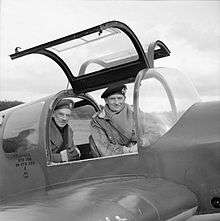John Burnett-Stuart
| Sir John Burnett-Stuart | |
|---|---|
 Field Marshal Montgomery and General Burnett-Stuart (left) in the cockpit of Montgomery's personal aircraft in North-west Europe, 8 March 1945 | |
| Born | 1875 |
| Died | 1958 |
| Allegiance |
|
| Service/branch |
|
| Years of service | 1895–1938 |
| Rank | General |
| Commands held |
Southern Command British Troops in Egypt 3rd Division Madras District in India |
| Battles/wars |
North-West Frontier Second Boer War First World War Malabar Rebellion |
| Awards |
Knight Grand Cross of the Order of the Bath Knight Commander of the Order of the British Empire Companion of the Order of St Michael and St George Distinguished Service Order |
| Other work | Deputy Lieutenant for Aberdeenshire |
General Sir John Theodosius Burnett-Stuart GCB, KBE, CMG, DSO, DL (1875–1958) was a British Army general in the 1920s and 1930s.
Military career
Educated at Repton School and the Royal Military College, Sandhurst, John Burnett-Stuart was commissioned into the Rifle Brigade in 1895.[1] He saw service on the North-West Frontier of India between 1897 and 1898.[1] He also served in the Second Boer War in South Africa between 1899 and 1902, being awarded the Distinguished Service Order in 1900.[1]
He served in the First World War as a General Staff Officer in the British Expeditionary Force rising to become Deputy Adjutant General at General Headquarters for the British Armies in France in 1917.[1]
After the War, in 1919, he was appointed General Officer Commanding Madras District in India where he was involved in the suppression of the Moplah Rebellion at Malabar between 1921 and 1922.[1] The riots that he quashed were inspired by 10,000 guerrillas and led to 2,300 executions.[2]
He returned to the United Kingdom and became Director of Military Operations and Intelligence at the War Office in 1923 and then General Officer Commanding 3rd Division in 1926.[1] In 1927 he directed exercises by an experimental Mechanised force on Salisbury Plain in Wiltshire.[1] He was appointed General Officer Commanding the British Troops in Egypt in 1931 and General Officer Commanding-in-Chief of Southern Command in 1934: he retired in 1938.[1]
He was also Aide-de-Camp General to King George V from 1935 to 1938 and Colonel Commandant of 1st Battalion Rifle Brigade from 1936 to 1945.[1] He commanded the 1st Aberdeen Battalion of the Home Guard[3] and was Deputy Lieutenant for Aberdeenshire.[1]
Further reading
- To Change an Army: General Sir John Burnett-Stuart and British Armoured Doctrine, 1927–38 By Harold R Winton, Elsevier, 1988, ISBN 978-0-08-036270-0
References
| Military offices | ||
|---|---|---|
| Preceded by Sir William Thwaites |
Director of Military Operations and Intelligence 1923–1926 |
Succeeded by Sir Ronald Charles |
| Preceded by Sir William Heneker |
General Officer Commanding the 3rd Division 1926–1930 |
Succeeded by Sir Harry Knox |
| Preceded by Sir Peter Strickland |
General Officer Commanding the British Troops in Egypt 1931–1934 |
Succeeded by Sir George Weir |
| Preceded by Sir Percy Radcliffe |
GOC-in-C Southern Command 1934–1938 |
Succeeded by Sir Archibald Wavell |
| Preceded by Sir Cameron Shute |
Colonel-Commandant of the 1st Battalion, Rifle Brigade (Prince Consort's Own) 1936–1945 |
Succeeded by Sir Ralph Eastwood |